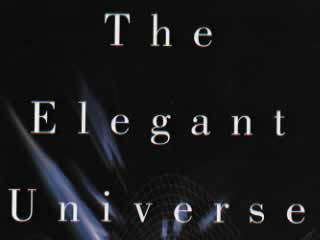
The Elegant Universe
Cat: SCI
Pub: 1999
#0225b
Brian Greene
02531u/18216r
Title
The Elegant Universe
エレガントな宇宙
Subtitle
Superstrings,
Hidden dimensions, and the Quest for the Ultimate Theory
超ひも理論、隠れた次元、究極の理論探求
Published
1999
1999年
Index
Why?
- Super String theory, M-Theory, General Relativity, Quantum Mechanics,
More dimensions, Black holes, and so on; all these concepts are
attractive and elegant, rather complicated and not easy to access.
But we are living in such a world with or without feeling them.
- 超ひも理論、M理論、一般相対論、量子力学、更なる次元、ブラックホールなど、これらの概念は魅力的でエレガントだが、複雑で近寄り難い。でも我々は感じようと感じまいとそのような世界に住んでいるのだ。
Summary
要約
>Top 0. Prologue:
- During the last thirty years of his life. Albert Einstein sought
relentlessly for a so-called unified field theory - a theory capable
of describing nature's forces within a single, all-encompassing,
coherent framework.
- Einstein never realized this dream. But during the past half-century,
physicists of each new generation have been building steadily
on the discoveries of their predecessors to piece together an
ever fuller understanding of how the universe works.
- The theory, superstring theory, is the subject
of this book.
- Superstring theory cast a wide net. Since the theory unifies
the laws of the large and of the small, laws that govern physics
out to the farthest reaches of the cosmos and down to the smallest
speck of matter.
0.プロローグ:
- 最後の人生の30年をかけて、アインシュタインはいわゆる統一理論を執拗に追求した。それは自然の力を単一で、すべてを包含する一環した仕組みによって記述できる理論である。
- アインシュタインはこの夢を実現できなかった。しかし過去半世紀の間、それぞれの新世代の物理学者は、先駆者の発見の断片を着実に積み上げ、宇宙がどう動くのかの理解を進めている。
- その理論である超ひも理論が本書のテーマである。
- 超ひも理論は幅広い。それは巨視の世界から微視の世界を、最も遠い宇宙を支配する法則から物質の根源にいたる法則までを対象としている。
>Top 1. The Three
conflicts:
- Three conflicts since Newton:
- Newton:
if you run fast enough you can catchup with a departing beam
of light, whereas according to James Clerk Maxwell's laws of
electromagnetism, you can't.
- Einstein's work:
Just as special relativity overturned previous conceptions of
space and time, so too did general relativity. Not only are
space and time influenced by one's state of motion, but they
can warp and curve in response to the presence of matter or
energy.
- Quantum mechanics and general relativity:
The third and deepest conflict arises from the incompatibility
between quantum mechanics and general relativity. String theory
is the story of space and time since Einstein.
1. 三つの衝突:
- 現代物理学の3つの衝突:
- ニュートン:
十分速く走れば、過ぎ去りつつある光の束を捕まえることができる、しかしマックスウェルの電磁気学ではそれは不可能である。
- アインシュタイン:
特殊相対論がそれ以前の空間・時間の概念をひっくり返したように、今度は一般相対論がそうした。運動の状態によって時空間が影響されるのみならず、物質とエネルギーの存在によって、その時空間をゆがめることができる。
- 量子力学と相対性理論:
三番目の深刻なコンフリクトは量子力学と相対性理論との不一致にある。ひも理論はアインシュタイン以降の時空間に関する物語である。
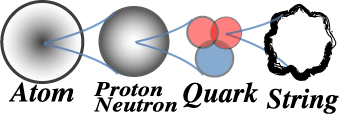 >Top The Universe at its smallest:
>Top The Universe at its smallest:
- 1968: Stanford Linear Accelerator Center found that protons
and neutrons are not fundamental. Instead they showed that each
consists of three smaller particles, called quarks.
A proton consists of 2 up-quarks and a down-quark; a neutron consists
of 2 down-quarks and an up-quark.
- late 1930s: another particle called a muon - identical
to an electron except that a muon is about 200 times heavier -
was discovered by physicists.
- mid-1950s: Frederic Reines and Clyde Cowan found conclusive
experimental evidence for a fourth kind of fundamental particle
called a neutrino - a particle whose existence was
predicted in the earl 1930s by Wolfgang Pauli
- Using ever more powerful technology, physicists have found:
four more quarks - charm, strange, bottom, and top - another even heavier cousin of the electron, called a tau,
as well as two other particles with properties similar to
the neutrino called the muon-neutrino and tau-neutrino,
to distinguish them from the original neutrino, now called
the electron-neutrino.
- Each of these particles has an antiparticle partner -
a particle of identical mass but opposite electric charge. (the
antiparticle of an electron is called a positron. When in contact, matter and antimatter can annihilate one another
to produce pure energy.
- 最小の宇宙:
- 1968:
Stanford Linear Accelerator Centerは、陽子と中性子が基礎の素粒子でないことを示し、各々さらに3つの小さなクォークという粒子からなることを示した。陽子は2つのアップ・クォークと1つのダウン・クォークから成り、中性子は2つのダウン・クォークと1つのアップ・クォークから成る。
- 1930年代末:
電子と同一で、質量が200倍重たいミューオンと呼ばれる素粒子が発見された。
- 1950年代半ば:F.ReinesとC. Cowanは、実験によって4番目の素粒子ニュートリノの確証を得た。これは1930年代にパウリによってその存在が予測されていたものである。
- さらに強力な技術を利用して、さらに多くのクォーク、チャーム、ストレンジ、ボトム、トップ・クォークを発見。また電子の仲間でさらに重たいタウを、またニュートリノの同類のミューオン・ニュートリノ とタウ・ニュートリノを発見した。最初のニュートリノは、区別のため電子ニュートリノと呼ぶ。
- これらの素粒子には反粒子が存在する。反粒子は同じ質量をもち、反対の電荷をもつ。電子の反粒子は 陽電子と呼ばれる。粒子と反粒子が接触すると互いに消滅しエネルギーを生成する。
- >Top The upshot is that physicist have now probed the structure of
matter to scales of about a billionth of a billionth of a meter.
- All of these interactions between various objects and materials
can be reduced to combinations of four fundamental force; gravitational
forces, electromagnetic force, the weak force, and the
strong force.
- The strong and the weak forces are less
familiar because their strength rapidly diminishes over all
but subatomic distance scales. The strong force is responsible
for keeping quarks glued together inside of protons and neutrons.
The weak force is known as the force for the radioactive decay
of substances.
- If you fire a laser beam - an electromagnetic ray gun - you
are firing a stream of photons.
- This smallest constituents of weak and strong force fields are
particles called weak gauge bosons and gluons.
- Physicists believe that the gravitation force also has an associated
particle; the graviton.
- 結論として、今や1mの百億分の1の百億分程度までの物質の構造が明らかになった。
- 各々の物質間の相互作用は以下の4つの基礎的な力の組合せに収束する。重力 、電磁力、弱い力、強い力である。
- 強い力と弱い力はあまり一般になじみがないのは、それらの力は原子中の距離を超えると急激に弱まることによる。強い力は陽子や中性子の内部でクォーク同士をくっつけている力であり、弱い力は放射性崩壊によって知られる力である。
- レーザービームは、電磁波の銃であり、それは光子の流れを打ち出している。
- 弱い力と強い力の世界の最小単位は、弱いゲージボゾンとグルーオンである。
- 重力は、グラビトンに関係していると信じられている。
Family-1
Family-2
Family-3
Particle
Mass
Particle
Mass
Particle
Mass
Electron
.00054
Muon
.11
Tau
1.9
Electron-neutrino
< 10^-8
Muon-neutrino
< .0003
Tau-neutrino
< .033
Up-Quark
.0047
Charm Quark
1.6
Top quark
189
Down-Quark
.0074
Strange Quark
.16
Bottom Quark
5.2
- Note: The above masses in multiples of the proton mass.
-
Force
Force particle
Mass
Strong
Gluon
0
Electromagnetic
Photon
0
Weak
Weak gauge bosons
86 or 97
Gravity
Graviton
0
- >Top 注:質量は陽子の質量比である
>Top2. The Essentials of Superstring Theory:
- I968: Gabriele
Veneziano realized that Euler beta-function seemed
to describe numerous properties of strongly interacting particle
in one fell swoop.
- 1970: Yoichiro Nanbu and Choler Nielsen, and Leonard Susskind
showed that if one modeled elementary particle as little, vibrating,
one-dimensional strings, their nuclear interaction could be describe
exactly by Euler's function. If the pieces of string were small
enough, they would still look like point particle, and hence could
be consistent with experimental observations.
- 1984-86: Green and Schwarz established contributed "the first
superstring revolution."
- 1995- : Edward Witen, one of the pioneers and leading experts
in string theory: "the second suprerstring revolution."
He said in 1998, "String theory is a part of 21st century
physics that fell by chance into the 20th century."
- The length of a typical strip loop is about the Planck length,
about a hundred billion billion (1020) times smaller than an atomic
nucleus.
- What are string made of? They are "atoms," uncuttable
constituents. As the absolute smallest constituents of anything,
they represent the end of the line - the last of the Russian matrioshka
dolls.
2.超ひも理論の本質:
- 1968: Gabriele Veneziano の強い力についての理論。オイラーのベータ関数を使えば、強く相互作用する粒子の特性がうまく記述できることを発見した。
- 1970:南部陽一郎、Holger Nielsen、Leonard Susskind の研究:小さな一次元の振動するひもを素粒子モデルとすれば、核相互作用をオイラーの関数でぴったりと記述できる。ひもは十分小さければ点粒子のように見え、観測結果と矛盾しない。
- 1984-86: GreenとSchwartzによる「 第一超ひも理論革命」
- 1995- :ひも理論の先駆者であるEdward Witenによる「第二次超ひも理論革命」。曰く
「ひも理論は、20世紀に偶然現れた、21世紀の物理学の一部である。」 (1998)
- ひもの長さは、プランクの長さ、即ち、原子核の1020分の1程度。
- ひもはアトムか?:
ひもの輪の長さは、ブランクの長さ程度=原子核の1020分の1
一応、ひもを自然の基本構成要素と見なす。ロシアのマトリョーシュカの最後の人形。
- >Top
 The
loops in string theory can vibrate in resonance patters - similar
to those of violin strings - in which a whole number of peaks and
troughs fit along their spatial extent.
The
loops in string theory can vibrate in resonance patters - similar
to those of violin strings - in which a whole number of peaks and
troughs fit along their spatial extent.
- The properties of an elementary "particle" are determined
by the precise resonant pattern of vibration that its integral string
executes. The greater the amplitude and the shorter the wavelength,
the greater the energy. From special relativity we know that energy
and mass are two side of the same coin.
- The perspective differs sharply; the difference among the
fundamental particles were explained by saying that each particle
species was cut from a different fabric. String theory alters
this picture radically by declaring that he stuff of all matter
is the same. Difference between the particles arise because
their respective strings undergo different resonant vibrational
patters. String theory provides the promise of a single unified
description of the physical universe; a theory of everything (TOE).
- >Top The strength of the force transmitted by the proposed graviton
pattern of string vibration is inversely proportional to the string's
tension.: a colossal tension of 1039 tons,
so-called Planck tension.
Fundamental strings are therefore extremely stiff compared with
more familiar examples.
- The huge string tension caused the loops of string theory
to contract to a minuscule size; a typical string having Planck
length 1.62×10−35 m.
- Because of the enormous tension, the typical energy of a vibrating
loop in string theory is extremely high. Quantum mechanics implies
that vibrations can exist only in discrete units; a string vibrational
pattern is a whole number multiple of a minimal energy denomination.
They are multiples of the Planck energy; which correspond to
masses that are on the order of 1019
times that of a proton. (Planck
mass) It's about equal to the mass of a
grain of dust or a collection of a million average bacteria.
- >Top If the "natural" energy scale of string theory is
1019 times that of a proton, how can it possible account for
the far-lighter particles - electrons, quarks, photons, and
so on.
- Through the weirdness of quantum mechanics, the energy associated
with the quantum jitters of a string is negative, and
this reduces the overall energy content of a vibrating string
by an amount the is roughly equal to Planck energy.
- For the vibrational pattern whose properties make it a candidate
for the graviton messenger particle, the energy cancellations
are perfect, resulting in a zero-mass gravitational force particle.
- As our most powerful particle accelerators can reach energies
only on the order of 1000 times the proton mass, less than 10−15
of the Planck energy (1.22×1015 GeV).
- It is possible that a super-heavy vibrational string state
- a relic form the big bang - did survive to the present.
- <左図>ひも理論の輪は、ひもの空間的広がりの中に整数個の山・谷がバイオリンの弦のように共振している。
- 素粒子の特性であるその質量とひもの異なる振動パターンが異なる質量と力荷を生む。振幅が大きいほど、また波長が短いほど、そのエネルギーは大きい。特殊相対論によればエネルギーと質量は同じコインの表裏である。
- この見解は従来の考えと際だって異なる。従来は素粒子間の違いは各々の素粒子の素材が異なると説明された。ひも理論では、この考えを全く変えて、すべての素材は同じであると主張する。各粒子間の違いは各々のひもが異なる共振振動パターンの違いに起因する。ひも理論は単一の統一的な記述、即ち万物の理論(TOE)
をもたらすと期待されている。
- グラビトンと思われたひもの振動パターンが伝える力の強さは、ひもの張力に反比例する。その張力は1039トン、いわゆるプランク張力という。基本的なひもは、普通のひもに比べて極めてきつく張られている。
- ひも理論のループは莫大な張力によって微小サイズに縮まっている。典型的なひもの長さはプランクの長さ1.62×10−35 mになる。
- この莫大な張力のために、ひも理論の振動するループの典型的なエネルギーは極めて大きい。量子力学では、この振動は不連続な形で存在し、ひもの振動パターンは最小エネルギー単位の整数倍である。それはプランクのエネルギーの整数倍である。これは質量に換算すると陽子の1019の倍程度に相当する。(プランク質量)
これは一粒の塵、または百万個のバクテリア集団の質量にほぼ等しい。
- もしひも理論の自然なエネルギー・スケールが陽子の1019倍なら、ずっと軽い電子、クォーク、光子などは一体どのように説明できるのか?
- 量子力学の奇妙さによって、ひもの量子的な小刻みな振動エネルギーはマイナスであるので、振動するひもが抱える総エネルギーはおよそプランク・エネルギーに等しい量だけ減少する。
- グラビトン・メッセンジャー粒子の候補の振動パターンはエネルギーの打ち消しが完全で、重力粒子の質量をゼロにする。
- 最も強力な粒子加速器でも、陽子質量の1000倍程度、プランク・エネルギーの1000兆分の1以下のエネルギーに到達するのがやっとである。
- ビッグバンの名残である超重振動のひもが今日まで生き残っている可能性はある。
- >Top We learn about the structure of an object is by hurling other
things at it and observing the precise way in which they are deflected.
We are able to see things, because our eyes collect and our brains
decode information carried by photons as they bounce off of objects
being viewed.
- As a general rule, the size of the probe particle that we
use set a lower limit to the length scale to which we are sensitive.
- A string, unlike a point particle, has two sources of smearing:
quantum jitters, as for a point particle, and also its own inherent
spatial extent. Increasing a string's energy decreased the smearing
form the first source but ultimately increase the smearing fro
the second.
- The new rules tell us that there is a limit to how finely
we can probe the universe.
- >Top
 When
matte and antimatter collide, they can annihilate in a flash of
pure energy, producing a photon. The central fact is that there
is an unambiguous, completely identifiable time and place where
this happens.
When
matte and antimatter collide, they can annihilate in a flash of
pure energy, producing a photon. The central fact is that there
is an unambiguous, completely identifiable time and place where
this happens.
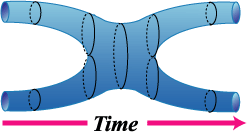 How
doe this description change if, they turn out to be one-dimensional
strings? Two strings collide and again annihilate each other in
a flash, The flash, a photon, is itself a string in a particular
vibrational pattern.
How
doe this description change if, they turn out to be one-dimensional
strings? Two strings collide and again annihilate each other in
a flash, The flash, a photon, is itself a string in a particular
vibrational pattern. - Fine sub-Planckian (10−35m) details
that would be accessible to a point-particle probe are smeared together
by string theory.
- 我々が物体の構造を知るためには、それにほかの物をぶつけて、曲がった方向がどう変化するかを観察する。我々が物を見ることができるのは、見られる物体から跳ね返る光子が運ぶ情報を脳が解読するからである。
- 一般的には、用いる探査粒子のサイズより小さな物を観察することはできない。
- 点粒子と異なり、ひもにはぼやける源が2つあるようだ。点粒子にある量子的な振動運動と、ひも自体に固有な空間的広がりである。ひものエネルギーを増すと、最初のぼやかしは減るが、二つ目の源からくるぼやかしが増える。
- 新たなルールでは、我々がどれほど微細に宇宙を探れるかについては限度がある。
- <左図>物質と反物質が衝突すると、それらは一瞬の内に純然たるエネルギーの中で消滅し、光子を生み出す。この核心は、これが起こる場所と時間が明確で、かつ完全に特定できることにある。
- <左図>この描写を、一次元のひもとするとどうなるか? 2つのひもは衝突し、閃光の内に消滅する。この閃光は光子で、それ自体ある振動パターンをもつひもである。
- 点粒子の探査体だったら探ることができたプランクの長さ(10−35m)以下の細部は、ひも理論によってほやかされてしまう。
>Top 3. The "Super" in Superstrings:
- Physicists describe these two properties of physical laws - that
they do not depend on when or where you use them - as symmetries
of nature.
- Are there any other symmetry principles having to do with space,
time, and motion that the laws of nature should respect?
- Uhlenbeck, etc. found that only one specific sort of electron
motion could give rise to the magnetic properties suggested by the
data; rotational motion - that is spin.
The spin of an electron is an intrinsic property, much like its
mass or its electric charge.
- All of the matter particles and their antimatter partners
as well have spin equal to that of the electron: "spin-1/2",
where the value 1/2 is a quantum-mechanical measure of how quickly
the particle rotate.
- Nongravitational force carriers - photons, weak gauge bosons,
and gluons - posses "spin-1."
- The hypothesized graviton must have to be the transmitter
of the gravitation force; "spin-2"
3.超ひもの超とは:
- 物理悪社は物理法則の2つの性質、即ち、いつどこで用いられるかにされない。これを自然の対称性という。
- 空間、時間、運動に係わる対称性原理で、自然法則が尊重しなければならないものが他にあるだろうか。
- Uhlenbeck他は、磁気的な性質を示し得る電子の特定の運動が一つだけあることを発見した。それが回転運動つまりスピンである。電子のスピンは一時的な運動状態ではない。質量や電荷のような固有の性質である。
- 物質粒子および対応する反物質粒子もすべて電子に等しいスピン1/2がある。
- 重力以外の力の担い手である光子、弱いゲージ・ボゾン、グルーオンはスピン1
- 仮説上のグラビトンが重力を伝える粒子であるためにはスピン2でなければならない。
- >Top Supersymmetry and Superpartners:
- Supersymmetry cannot be associated with a simple and intuitive change
in observational vantage point. But just as spin is "like rotational
motion, with a quantum-mechanical twist," supersymmetry can be associated with a change in observational vantage point in
a "quantum-mechanical extension of space and time."
- By the mid-1970s, detailed theoretical analysis showed that
if the universe incorporates supersymmetry, then every known
particle must have an as-yet-undiscovered superpartner particle,
whose spin is half a unit less than its known counterpart.
- Spin-0 partner
of electron (selectron) , the hypothetical spin-0 superpartners
of neutrinos and quarks being called sneutrinos and squarks.
- Similarly, the force particles should have spin-1/2 superpartners; For photons there should be photinos,
for gluons should be gluinos,for W and Z bosons should
be winos and zinos.
- >Top One of the puzzling features of nature's four forces is the huge
range in their intrinsic strengths.
- The electromagnetic force has
less than 1% of the strength of the strong force, the weak force
is some 1000 times feebler than that, and the gravitational force
is some 10−35 times weaker still.
- Whereas the electromagnetic and weak forces crystallized out
of a more symmetric union when the temperature of the universe
dropped to about 1015 Kelvin, while the union with the strong
force would have been apparent only at a temperature some 1028
Kelvin.
- Hot early universe when it was about 10-39 of a second old
- when its temperature was on the order of 1028 Kelvin - the
strong, weak, and electromagnetic forces all merge into one
grand force at such immense temperatures.
- Superpartner particles might be a 1000 times as massive as
a proton. Even our state-of-the-art accelerators cannot quite
reach such energies.
- >Top Five supersymmetric string theories are called the
Type I theory, the Type IIA theory, the Type IIB theory, the Heterotic
type O(32) theory, and the Heterotic type E8 x E8 theory. In the
wry words of Witten, "If one of the five theories describes
our universe, who lives in the other four worlds?"
- Recent research has taken suprerstring theory one giant step closer
to this unified utopia by showing that the five different theories
are actually five different ways of describing one and the same
overarching theory. Suprerstring theory has the uniqueness pedigree.
- 超対称性とスーパーパートナー:
- 超対称性は、単純かつ直感的にわかるような観測地点の変化と結びつけることはできない。あたかもスピンが「量子力学的なひねりをもつ回転運動に似ている」ように、超対称性を「空間と時間を量子力学的に拡張した」ような観測的な立場の変化と結びつけることができる。
- 1970年代半ばまでに、詳しい理論分析によって、宇宙が超対称的であれば、既知のどの粒子にもスピンが半単位だけ小さい未発見のスーパーパートナーがあることがわかった。
- 電子ににはスピン0のパートナー(超電子)
があり、ニュートリノやクォークには仮説上のスピン0の超ニュートリノや超クォークがあるはずである。
- 同様に、力の粒子にはスピン1/2のスーパーパートナーがあり、光子にはフォチーノ、グルーオンにはグルーイノ、WボゾンとZボゾンには、ウィーノとジーノがあるはずである。
- 自然の4つの力が示す謎めいた特徴の一つは、4つの力の固有の強さが大きく違っていることである。
- 電磁力の強さは強い力の1%以下に過ぎず、弱い力はそのまた1000倍も小さく、また重力は10−35程度である。
- 電磁力と弱い力は、宇宙の温度が1015度Kまで下がった時に、もっと対称的な統一体から析出し、また強い力との統一は1028度Kでしか現れてこない。
- スーパーパートナー粒子の質量は陽子の1000倍に達するかも知れない。最先端の加速器でもそのようなエネルギーは実現できない。
- 5つの超対称的ひも理論はI型理論、IIA型理論、IIB型理論、ヘテロO(32)型理論、ヘテロE8 x E8型理論と呼ばれる。Wittenの辛辣な言葉によれば「5つの理論の内の一つが我々の宇宙を記述するとすれば、他の4つの世界には誰が住んでいるのか?」
- 最近の研究では、5つの理論は実はすべてに勝る同じ一つの理論を記述する5通りの方法であることがわかった。超ひも理論は、唯一という血統書を持ったのである。
>Top 4. Invisible
Dimensions:
- Experience informs intuition. but it does more than that; Experience
sets the frame within which we analyze and interpret what we perceive.
- In 1919, Polish mathematician Theodor Kaluza suggested that the
universe might not actually have three spatial dimensions; it might
have more. Kaluza sent his paper to Einstein, and at first Einstein
was quite intrigued.
- Imagine that a few hundred feet of garden hose is stretched across
a canyon: there is a clear difference between these two dimensions.
The direction along the length of the hose is long, extended, and
easily visible. The direction circling around the thickness of the
hose is short, "curled up," and harder to see.
- Swedish mathematician Oskar Klein in 1926 refined that the spatial
fabric of our universe may have both extended and curled-up dimensions.
(Kaluza-Klein theory)
4.見えない次元:
- 経験は直感の基となる。しかしそれ以上のこともする。経験は我々に枠組みを用意し、その中で、我々が近くするものを分析し解釈する。
- 1919年にポーランドの数学者Thoedor Kaluzaは、宇宙は実際には3次元空間ではなく、もっと次元があるかも知れないことを示唆した。Kaluzaはこの論文をアインシュタインに送った。アインシュタインは困惑した。
- 100mの長さのホースが谷をまたいで張ってあるとしよう。2つの次元には明らかな違いがある。ホースの長さにそって方向は長く伸びており簡単にみえる。ホースの太さの方向は、巻き上げられており、見ることは困難である。
- 1926年に、スウェーデンの数学者Oskar Kleinはそれを明確にし、我々の宇宙には拡がった空間次元と巻き上げられた次元とがあるとした。
(カルーザ・クライン理論)
- >Top
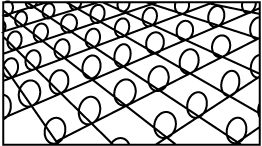 <Right
figure>
<Right
figure>
The grid lines represent the extended dimensions of common experience,
whereas the circle are a new, tiny, curled-up dimension. Like
the circular loops of thread making up the pile of a carpet, the
circles exist at every point in the familiar extended dimensions.
-
-
<Right figure>
Two extra dimensions curled up in the shape of a hollow doughnut,
or torus.
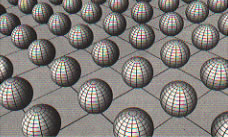 <左図>格子線は、いつも経験する拡がった次元を表し、円は小さな巻き上げられた次元を示す。カーペットのパイルをなす環状の意図のループのように、円はおなじみの拡がったすべての点に存在する。
<左図>格子線は、いつも経験する拡がった次元を表し、円は小さな巻き上げられた次元を示す。カーペットのパイルをなす環状の意図のループのように、円はおなじみの拡がったすべての点に存在する。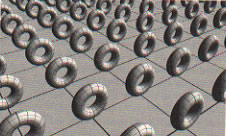 <左図>
<左図>- 球場の形に巻き上げられた新たな2つの次元
- <左図>穴の開いたドーナツ状に巻き上げられた新たな2つの次元
- >Top
Modern Kaluza-Klein
Theory:
-
By the mid 1970s, intense research effort was underway,
focusing on higher-dimensional theories with numerous curled-up
spatial directions. The right figure illustrates an example with
two extra dimension that are curled up into the surface of a ball.
As in the case of the single circular dimension, these extra dimensions
are tacked on to every point of the familiar extended dimensions.
-
One can also imagine other shapes for the extra
dimensions; there are again two extra dimensions, now in the shape
of a torus. The essential requirement is that all of these dimensions
have a spatial extent smaller than the smallest length scales
we can probe, since no experiment has yet revealed their existence.
- >Top
-
Why does string theory require the particular
number of nine space dimensions to avoid nonsensical probability
value? This is probably the hardest question in string theory
to answer without appealing to mathematical formalism.
- Approximate calculation actually misses one space dimension.
String theory actually requires ten space dimensions
and one time dimension, for a total of eleven dimensions.
- If a curled-up dimension is a time dimension, traversing it
means returning, after a temporal lapse, to a prior instant
in time. This, of course, is well beyond the realm of our experience.
But the intriguing possibility of new time dimensions could
will play a role in future developments.
- その後のカルーザ・クライン理論:
- 1970年代半ばには、巻き上げられた多くの空間次元を含む高次元理論に焦点を当てた集中的な研究が続けられた。上図は、球体の表面に巻き上げられた追加の二次元を含んだ例を示している。一個の感情の次元の場合と同じく、これらの追加の次元は、おなじみの広がった次元のすべての点にくっついている。
- また新たな次元を他の形で想像することもできる。上図は新たな二次元が、今度はトーラスの形をしている例を示した。これらの新たな次元はいずえも探査可能な最小限の長さより小さいということが不可欠の条件となる。それは実験ではまだそのような次元の存在が明らかになっていないからである。
- なぜひも理論は、無意味な確率値を避けるために、9つの空間次元を必要とするのか。これは数学を使わずに説明するのが最も難しい質問である。
- 近似計算は実は、空間次元を一つ見落としていた。ひも理論は実際には、空間次元を10個、時間次元を1個、合計11次元を必要とする。
- もし巻き上げられた次元が時間次元とすると、それはある時間が経過した後で以前の時点に戻ることになる。これはもちろん我々の経験領域を超えている。しかし新たな時間次元の興味をそそる可能性が将来の発展に何らかの役割を演じることはあり得る。
- >Top
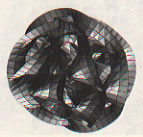 The universe is made up of tiny string whose resonant
patterns of vibration are the microscopic origin of particle masses
and force charge. String theory also requires extra space dimension
that must be curled up to a very small size to be consistent with
our never having seen them. But a tiny string can probe a tiny
space. The patterns of string vibrations appear to us as the masses
and charges of the elementary particles, we conclude that these
fundamental properties of the universe are determined by the geometrical
size and shape of the extra dimensions.
The universe is made up of tiny string whose resonant
patterns of vibration are the microscopic origin of particle masses
and force charge. String theory also requires extra space dimension
that must be curled up to a very small size to be consistent with
our never having seen them. But a tiny string can probe a tiny
space. The patterns of string vibrations appear to us as the masses
and charges of the elementary particles, we conclude that these
fundamental properties of the universe are determined by the geometrical
size and shape of the extra dimensions.
- >Top <Right
figure>
One example of a Calabi-Yau space:→
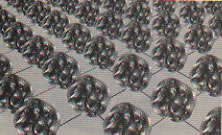 What do the curled-up dimensions look like? In 1984: These are
known as Calabi-Yau spaces in honor of two mathematicians, Eugenio
Calabi and Shing-Tung Yau. We are trying to represent a 6-dimensinal
shape on a 2-dimensional piece of paper.
What do the curled-up dimensions look like? In 1984: These are
known as Calabi-Yau spaces in honor of two mathematicians, Eugenio
Calabi and Shing-Tung Yau. We are trying to represent a 6-dimensinal
shape on a 2-dimensional piece of paper.
- >Top <Right
figure>
According to string theory, the universe has extra dimensions curled
up into a Calabi-Yau shape.
- To put it all together, at every point in the three familiar extended
dimensions, string theory claims that there are six hitherto unanticipated
dimension, tightly curled up into one of these rather complicated-looking
shapes as below figure. Of course, because the curled-up dimensions
are so small, as you move your hand your circumnavigate them an
enormous number of times, repeatedly returning to your starting
point.
- 宇宙は小さなひもでできていて、その共振パターンが粒子の質量と力荷の原因となる。またひも理論は追加の空間次元を必要とし、それらは、我々が観察できないということと矛盾しないように非常に小さなサイズに巻き上げられている。しかし小さなひもは小さな空間を動くことができる。ひもの振動パターンは我々には素粒子の質量と力荷として現れるので、我々は宇宙の基本的性質は、新たな次元の幾何学的な大きさと形で決まると結論づけている。
- <左図>カラビ・ヤウ空間の一例
- 巻き上げられた次元はどんな形をしているか。
1984年に、2人の数学者Eugenio Calabi and Shing-Tung Yauに敬意を表して、カラビ・ヤウ空間と呼ばれる。我々は、6次元の形を2次元の紙の上に表現しようとしている。
- <左図>ひも理論によれば、宇宙には痛快の次元がありカラビ・ヤウ図形の中に巻き上げられている。
- これらを求めると、おなじみの広がった3つの次元のすべての点にこれまで予想されなかった6つの次元があり、それらは堅く巻き上げられていて、以下の図のようにかなり複雑に見える図形をしている。もちろんその巻き上げられた次元は非常に小さいので、手を振って弧を描くときは巻き上げられた次元の中何度も繰り返して、元の位置に戻ってくることになる。
>Top 5. The road
to experiment:
- There are yet other ways in which evidence for string theory might
be found. The size of a string is typically the Planck length, but
strings that are more energetic can grow substantially larger. The
energy of the big bang, would have been high enough to produce a
few macroscopically large string that might have grown to astronomical
scales.
- Closer to earth, there are other possible experimental signature
of string theory. Here are five examples.
- >Top First, a challenge to string theory is to provide
a compelling explanation of present and future neutrino data, especially if experiments ultimately show the neutrinos do
have a tiny but nonzero mass. (In 1998 it has proved to have a weight.)
- Second, the possible disintegration
of the proton and the possible transmutations and
decays of various combinations of quarks, in violation of certain
long-established properties of point-particle quantum field theory.
If observed, any one of these processes would provide fertile ground
for string theory to offer an explanation.
- Third, for certain choices of the Calabi-Yau
shape there are particular patterns of string vibration
that can effectively contribute new,
tiny, long-range force fields. They might well reflect
some of the new physics of string theory.
- >Top Fourth, astronomers have collected evidence that
our galaxy and possibly the whole of the universe is immersed in
a bath of dark matter,
the identity of which has yet to be determined. Through its many
possible patterns of resonant vibration, string theory suggests
a number of candidates for the dark matter.
- Fifth, the cosmological
constant is the modification Einstein temporarily
imposed on his original equations of general relatively to ensure
a static universe.
Although the subsequent discovery that the universe is expanding
led Einstein to retract the modification, physicists have since
realized that their is no explanation for why the cosmological constant
should be zero. In fact, it can be interpreted as a kind of overall energy stored in the vacuum of space, and hence
its value should be theoretically calculable and experimentally
measurable. Calculations indicate that quantum-mechanical fluctuations
in the vacuum of empty space tend to generate a nonzero cosmological
constant whose value is some 120 orders of magnitude larger than
experiment allows.
5.検証への道:
- 他にもひも理論の証拠が見つかるかも知れない。ひもの典型的な長さはプランク長さだが、もっとエネルギーが大きいひもはずっと大きくなり得る。ビッグバンのエネルギーは巨視的な大きさのひもを生み出すのに十分だったはずである。
- 地上の近くにも、ほかにひも理論を実験できる痕跡の可能性がある。それは次の5つの分野である
- 第一に、もし実験の結果、ニュートリノの質量がゼロでないことがわかれば、(1998年に質量があることが判明)、ひも理論にとって、現在および将来のニュートリノのデータについて説得力のある説明が課題となる。
- 第二に、陽子の崩壊およびクォークの様々な組合せと崩壊の可能性がある。その場合、長い間証明されたきた点粒子の量子場理論に背く結果となる。もしこうしたプロセスが観察されれば、ひも理論にとって説明を提示するための有利な地盤となる。
- 第三に、カラビ・ヤウ図形のいくつかに対し、新しい、微小で長距離の力の場を生み出すひもの振動パターンがある。それはひも理論の新たな物理学の一部を反映している。
- 第四に、天文学者は我々の銀河およびおそらく宇宙全体が暗黒物質に満たされている証拠を集めている。暗黒物質の正体はまだわからない。ひも理論は共振パターンの中から暗黒物質の候補をいくつか示唆している。
- 第五に、宇宙定数はアインシュタインが静的な宇宙となるように一般相対論に一時的に付け加えた修正である。その後、宇宙が膨張していることが発見され、アインシュタインはこの修正を撤回したが、物理学者は宇宙定数がゼロでなければならない利用を説明できないないことに気づいた。実際、それは真空に蓄えられたあるエネルギーと解釈でき、その値は理論的に計算でき、かつ実験でも測定できるはずとされた。計算では真空の量子力学的ゆらぎは実験結果の10120にも達し、ゼロでない宇宙定数を生み出す傾向となる。
>Top 6. Quantum
Geometry:
- Whereas general relativity asserts that the curved properties
of the universe are described by Riemannian geometry, string theory
asserts that this is true only if we examine the fabric of the universe
on large enough scales. On scales as small as the Planck length
a new kind of geometry must emerge; called quantum geometry.
- Instead of considering all 10 of the spacetime dimensions of string
theory, or even 4 extend spacetime dimensions - let's go back tot
he Garden-hose universe. Garden-hose universe starts out nice and
plump but then shrinks to shorter size, approaching the form of
Lineland, a partial version of the big crunch.
- Strings that wrap around a circular component of space share almost
all of the same properties; their oscillations contribute strongly
to their observed properties. The essential difference is that a
wrapped string has a minimum mass, determined by the size of the
circular dimension and the number of times it wraps around. The
string's oscillatory motion determines a contribution in excess
of this minimum.
6.量子幾何学:
- 一般相対論では、宇宙の湾曲した性質はリーマン幾何学で記述されるが、ひも理論によれば、これが成り立つのは十分大きなスケールで宇宙の織物を調べた場合だけである。プランクの長さほどの小さいスケールでは新たな幾何学、量子幾何学が必要となる。
- ひも理論の時空次元の10個を考えるのではなく、さらに4次元の拡がった時空次元でもなく、ホース宇宙に戻って考えることにする。ホース宇宙は始めはまるまるしていたが次第に細くなって、線の国に近づく。単純化したビッグクランチである。
- この円形の空間の周りに巻きついたひもも、巻かれていないひもと同様の固有の性質を示す。その振動は観察される性質に強く寄与する。本質的な違いは、巻かれたひもには、円形の次元のサイズと何回巻かれたかによって最小質量があることである。ひもの質量がその最小質量をどれほど超えたかはひもの振動運動で決まる。
 Strings
can move on a cylinder in two different ways - in "unwrapped"
or "wrapped" configurations
Strings
can move on a cylinder in two different ways - in "unwrapped"
or "wrapped" configurations
- >Top String theory claims that all physical process in the Garden-hose
universe in which the radium of the circular dimension is shorter
than the Planck length and is decreasing are absolutely identical
to physical processed in which the circular dimension is longer
than the Planck length and increasing! As the circular dimension
shrinking down to the Planck length and then proceeding to expand;
cosmic collapse is now seen to be a cosmic bounce.
- First, uniform vibrational excitations of a string have energies
that are inversely proportional to the radium of the circular
dimension. a smaller radium more strictly confines a string
and therefore, through quantum-mechanical claustrophobia, increases
the amount of energy in its motion.
- Second, the winding mode energies are directly proportional
to the radius. This is because the minimum length of wound string,
and hence their minimum energy, is proportional to the radius.
- These two establish that large value of the radium imply large
winding energies and small vibration energies, whereas small
values of the radius imply small winding energies and large
vibration energies.
- As physical properties are sensitive to the total energy of
a string configuration: So strangely enough, there is no difference
whatsoever between a fat Garden-hose universe and a thin one.
- >Top To put some rough numbers in, if the familiar dimensions are circular
then their radii must be about as large as the 15 billion light-years,
which is about R=1061 times the Planck length, and growing as the
universe expands. If string theory is right, this is physically
identical to the familiar dimensions being circular with incredibly
tiny radii of about 1/R =10−61 times the Planck length!
- In the realm of the discipline of quantum geometry, there
are two notions of distance. We find a concept to distance that
meshes with both our intuition and with general relativity when
distance scales are large, but that differs from them dramatically
when distance scales get small. Specifically, sub-Planck-scale
distances are inaccessible.
- <左図>ひもはホースの補湯面で2通りの動きをする。巻かれていない状態と巻かれたた状態である。
- ひも理論によれば、円形の次元の半径がプランクの長さよりも短く縮んでいくホース宇宙と、円形の次元の半径がプランクの長さより長く拡がっていくホース宇宙では、物理プロセスはすべて完全に同一である。円形の次元がプランクの長さまで縮んだ後で膨張する。崩壊した宇宙は今や跳ね返えるように見える。
- まず、ひもの一様振動エネルギーは、環状次元の半径に反比例する。この半径が小さいほど、ひもは狭い範囲に閉じこめられるので、量子力学的な閉所恐怖症によって、ひもの運動エネルギーが増加する。
- 次に、巻きつきモードのエネルギーは半径に正比例する。これは巻かれたひもの最小限の長さ、即ち最小限の円が、半径に比例するからである。
- これら2つの結果、半径が大きければ、巻きつきエネルギーが大きく、振動エネルギーが小さい。逆に、半径が小さければ、巻きつきエネルギーが小さく、振動エネルギーが大きいことになる。
- 物理的性質はひもの位置の総エネルギーに影響される。従って奇妙なことに、太ったホース宇宙と細いホース宇宙の間に違いはないことになる。
- 大まかな数字だが、通常の次元を環形とするとその半径は150億光年位で、これはプランクの長さの R=1061であり、かつ宇宙は膨張している。もしひも理論が正しければ、これは通常の次元が極端に小さくて、プランクの長さのおよそ
1/R =10−61倍の場合と物理的には同じになる。
- 量子幾何学の分野では、距離の概念が2つある。距離のスケールが大きい場合には、我々の直感とも一般相対論とも合うが、距離スケールが小さくなると、どちらとも劇的に合わなくなる。要するにプランクの長さ以下の距離には到達不可能なのである。
>Top 7. Beyond Strings: M-Theory:
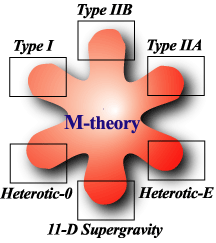 By
incorporating the dualities, all five string theories, 11-dimensional
supergravity, and M-theory are merged together into a unified framework.
By
incorporating the dualities, all five string theories, 11-dimensional
supergravity, and M-theory are merged together into a unified framework.
- M-Theory:
The name stands for as many thins as people you poll. Some samples:
Mystery Theory, Mother Theory, Membrane Theory, Matrix Theory.
- There is an old proverb about three blind men and an elephant.
Since their mutual descriptions are so different, and since
none of the men can see the others, each thinks that he has
grabbed hold of a different animal.
- >Top Recall that large/small circular radium duality that interchanges
a circular dimension of radius R with one whose radius is 1/R. Type
IIA and Type IIB string theories actually get exchanged by this
duality, as do the Heterotic-O and Heterotic=E strings. The physics
of the Type IIA string in a universe with a circular dimension of
radius R is absolutely identical to the physics of the Type IIB
string in a universe with a circular dimension of radius 1/R. They
are all sewn together into a single theoretical framework.
- If we start in either the Heterotic-E or Type IIA regions and
turn the value of the respective string coupling constants up, we
migrate toward the center of the above map, and what appeared to
be one-dimensional strings stretch into two-dimensional membranes.
7.ひも理論を超えて、M理論:
- <左図>5つのひも理論と11次元超重力理論とM理論は、双対性によって一つの理論的枠組みに統合される。
- M理論:
この名前は十人十色の解釈がある。謎の理論、母なる理論、膜理論、マトリックス理論。
- 3人の盲人と象の寓話がある。互いの描写が異なり、また互いに見えないので、各々違う動物に触れていると考える。
- 大小の半径の双対性によって、半径Rの環状次元と半径1/Rの環状次元とが入れ替わることを想起しよう。IIA型ひも理論とIIB型ひも理論、そしてヘテロOひも理論とヘテロEひも理論が、双対性によって入れ替わる。半径Rの環状次元をもつ宇宙でのIIA型ひも理論の物理は、半径1/Rの環状次元をもつ宇宙でのIIB型ひも理論の物理とは全く同一になる。それらはすべて単一の理論的枠組みの中に組み込まれている。
- もし我々は、ヘテロEとIIA型の領域のどちらかから出発して、各々のひも結合定数の値を大きくしていくと、我々は左図の中心に向かって移動し、一次元のひもと見えたものは、引き延ばされて二次元の膜になる。
>Top 8. Black
Holes: A String Perspective:
- John Wheeler summarized, "black holes have no hair."
Any two black holes with the same mass, force charges, and spin
are completely identical. Recall that it is precisely such properties
- mass, force charges, and spin - that distinguish one elementary
particle from another. Black holes might actually be gigantic elementary
particles.
- According to Einstein's theory, there is no minimum mass for
a black hole. As we try to make ever less massive black holes,
there comes a point when they are so light and small that quantum
mechanics does comes into play. (From the point of view of elementary
particle, the Planck mass is huge- 1019 times mass of a proton.)
- >Top Black hole entropy:
In 1970, Jacob Bekenstein: What if the vacuum pumps all the air,
and all the contents on the desk, and even the desk itself into
the back hole, leaving you in a cold, airless, thoroughly ordered
room? Since the entropy in your room has certainly decreased, the
second law of thermodynamics would be for the black hole to have
entropy.
- Stephen Hawking showed that the area of the event horizon
of a black hole always increased in any physical interaction.
Bekenstein proposed that the area of the event horizon of a
black hole provides a precise measure of its entropy.
- With so few defining features, a black hole appears to lack
sufficient structure to allow for disorder.
8.ブラックホールとひも理論:
- John Wheeler 曰く、「ブラックホールには毛がない。」質量、力荷、スピンが同じであれば、ブラックホールは完全に同一である。同様に素粒子同士を区別するのは、正にこのような属性ー質量、力荷、スピンである。ブラックホールは巨大な素粒子かも知れない。
- アインシュタインの理論によると、ブラックホールの質量には下限がない。ブラックホールの総質量がプランク質量程度になると、量子力学が働き始める。
(素粒子の視点から見るとプランク質量は陽子の1019もある。)
- ブラックホール・エントロピー:
1970年にJacob Bekensteinの説。もし真空ポンプで空気や机上のもののすべて、さらに机そのものもブラックホールの中に吸い込み、自分は冷たい空気のない秩序だった部屋に残ったとしたらどうなるか。部屋のエントロピー量は確かに減少し、熱力学第二法則によればブラックホールはエントロピーを持つことになる。
- S. ホーキングは、ブラックホールの事象地平の面積は、どのような物理相互作用を受けても常に増大することを示した。Bekensteinは、ブラックホールの事象地平の面積は、そのエントロピーを正確に示していること提唱した。
- ブラックホールの特徴があまりにも少ないので、無秩序になりようがないように思えた。
- >Top How Black Hole is black?
In 1974, Hawking realized that the gravitational might of the black
hole can inject energy into a pair of virtual photons, that tears
them just far enough apart so that one gets sucked into the hole.
With its partner having disappeared into the abyss of the hole,
the other photon of the pair no longer has a partner with which
to annihilate. The remaining photon gets an energy boost from the
gravitation force of the black hole and as its partner fall inward,
it gets shot outward, away from the black hole. Black holes glow.
- Bekenstein was right; these results showed that it is much
more than an analogy - it is an identity. A black hole has entropy.
a black hole has temperature. A black hole whose mass is about
3 times solar mass has a temperature of about 10^-8 K. A black
hole as light as a small asteroid would emit about as much radiation
as a million-megaton H-bomb, with radiation in gamma-ray spectrum.
- The more massive the black hole, the greater the entropy.
The enormous amount of disorder embodied by a black hole.
- Once Hawking informed that black holes radiates, the story changed.
Radiation carries energy and its mass slowly decreased - it slowly
evaporates. As it does so, the event horizon slowly shrinks. Does
the information contained in the things swallowed by the black hole
reemerge as the black hole evaporates?
- Hawking has strongly claimed that the information does not
reemerge - that black holes destroy information thereby "introducing
a new level o uncertainty into physics."
- 1997年、ホーキングの発見:ブラックホールの重力が一対の仮想光子にエネルギーを渡し、一方だけがブラックホールに吸い込まれるように、2つを引き離すことがあり得る。対をなす光子の一方がブラックホールの深淵に吸い込まれると、他方はもはや一緒に消滅すべき相手がなくなる。さらにこの光子はブラックホールの重力からエネルギーを得る。もう一方の光子が内側に向かって落ちていく間、こちらの光子は外にはじき飛ばされブラックホールから遠ざかる。ブラックホールは光るのである。
- Bekensteinは正しかった。これらは類似しているどころか同一だったのだ。ブラックホールはエントロピーをもち、温度もある。太陽質量の3倍のブラックホールの温度は約1億分の1度Kになる。小惑星ほどの重さのブラックホールなら、100万メガトンの水爆と同じ位で、ガンマ線スペクトルを放射する。
- ブラックホールは質量が大きいほどエントロピーが大きい。これはブラックホールが膨大な無秩序を抱えていることを示している。
- ブラックホールは放射を発するとホーキングが述べたことで事情は一変した。放射はエネルギーを運ぶので、その質量は徐々に減少する。それはゆっくりと蒸発する。そうすると事象地平も後退する。そうなるとブラックホールに飲み込まれた情報はブラックホールの蒸発に伴って再び現れるのか?
- ホーキングは情報は再現しないと強く主張する。ブラックホールは情報を破壊することで、「新たなレベルの不確定性を物理学に持ち込む」という。
>Top 9. Reflections on Cosmology:
- Humans throughout history have had a passionate drive to understand
the origin of the universe. There is, perhaps, no single question
that so transcends cultural and temporal divides, inspiring the
imagination of our ancient forebears as well as the research of
the modern cosmologist.
- Alexander Friedmann found a solution in Einstein's equations that
declares that the universe violently emerged from a state of infinite
compression.
- Hubble's detailed observations of a few dozen galaxies confirmed
that the universe is expanding.
- The temperature of the universe a mere 10−43 seconds ATB (after the bang), the Planck time, is calculated
to have been about 1032 Kelvin.
- At about 1/100,000 of a second ATB, things cooled sufficiently (10 trillion Kelvin)
for quarks to clump together in group of three, forming protons
and neutrons.
- 3 minutes ATB,
as the simmering universe cooled to about a billion degrees, the
predominant nuclei that emerged were those of hydrogen and helium.
(the period of primordial nucleosynthesis)
- Few 100,000 years ATB,when the temperature had dropped to a few thousand
degrees, wildly streaming electrons slowed down to the point where
atomic nuclei, mostly hydrogen and helium, could capture them, forming
the first electrically neutral atoms. From that time onward, photons
from the bang have traveled unhindered and the full expanse of the
universe gradually came into view.
- A billion years ATB, with the universe having substantially calmed down
form its frenetic beginnings, galaxies, stars, and ultimately planets
began to emerge as gravitationally bound clumps of the primordial
elements.
9.宇宙論再考:
- 人間は歴史を通じて宇宙の起源を理解したいと熱烈に望んできた。文化と時間の断絶をこれほど超越する問いはおそらくなかった。古代人の想像をかきたててきたし、現代の宇宙論学者の研究も刺激している。
- A.フリードマンは、宇宙は圧力無限大の状態から爆発的に生まれたとする解をアインシュタインの式の中に見つけた。
- ハッブルは数十個の銀河を詳細に観測した結果、宇宙が膨張していることを確認した。
- ビッグバン後 (ATB) 10−43秒後、プランク時間での宇宙温度は、およそ1032度Kであった
- ビッグバン後、1/100,000秒後、温度は10兆度Kに下がり、クォークが3つ集まり組を成し、陽子や中性子が形成された。
- 続く3分間、煮えたぎる宇宙は10億度Kにまで冷え、主として水素のヘリウムの原子核が現れた。
(原子核合成期という)
- 続く数十万年の間に、温度は数千度に下がり、激しい電子の流れが遅くなり、主に水素とヘリウムの原子核が電子を捕まえ、電気的に中性の原子が作られた。その時以来、ビッグバンで生まれた光子は妨げられることなく進むようになり、宇宙全体が徐々に晴れ上がってきた。
- およそ10億年後、狂乱状態にあった宇宙も落ち着き、原始の元素が重力で引きつけあって塊をなし、銀河、恒星、最後には惑星が登場した。
- >Top
- From the Planck Time (10−43 seconds) to 1/100 second
ATB:
- About 10−35 seconds ATB, the strong, weak, and electromagnetic
forces were all one "grand unified" or "super"
force. In this state the universe was far more symmetric than it
is today.
- Between the Planck time and 1/100 of a second ATB, the universe
passed through at least two analogous phase transitions:
- As the temperature dropped below 1028 Kelvin, the universe
underwent a phase transition in which the three forces crystallized
out.
- Below 1015 Kelvin, the electromagnetic and weak forces too
crystallized out.
- プランク時間(10−43秒)からビッグバン1/100秒後まで:
- ビッグバン10−35秒後まで、強い力、弱い力、電磁力はすべて「大統一」力あるいは「超」力だった。この状態の宇宙は今よりずっと対称的だった。
- ビッグバン後からプランク時間と1/100秒後の間に、宇宙は少なくとも2回の相転移があった。
- 温度が1028度K以下に下がると相転移が起こり3つの力が析出してきた。
- 1015度K以下となると、電磁力と弱い力が析出した。
- >Top
 Inflation
model:
Inflation
model:
In 1979, a physicist Alan Guth found another solution to Einstein's
equations in which the very early universe undergoes a brief of
enormously fast expansion; standard cosmological model is modified
during a tiny window of time - around
10−36 to10−34 seconds ATB
- in which the universe expanded by colossal factor of at least
1030.
- インフレーション・モデル:
1979年に物理学者Alan Guthはアインシュタインの式のもう一つの解を見つけた。それは宇宙はごく初期に急激に膨張したというものである。標準宇宙モデルは、ビッグバン後のほんの短い間10−36から
10−34秒の間に、宇宙は1030倍へともとてつもない倍率で膨張したという。
- >Top In the beginning there was a Planck-sized Nugget:
In the late 1980s, Robert Brandenberger and Cumrun Vafa pictured:
First, as we run the clock backward in time toward the beginning,
the temperature continues to rise until the size of the universe
is about the Planck length in all directions. But then, the temperature
hits a maximum and begins to decrease.
- In the beginning, all of the spatial dimensions of string theory
are tightly curled up to their smallest possible extent, which is
roughly the Planck length. The temperature and energy are high,
but not infinite.
- Then, the universe goes through its first stage of symmetry reduction
when, at about the Planck time, three of the spatial dimensions
are singled out for expansion, while all others retain their initial
Planck-scale size. These three space dimensions are then identified
with those in the inflationary cosmological scenario.
- Why three?
In the first moment of the universe, the tumult from the high, but
finite, temperature drives all of the circular dimensions to try
to expand. As they do, the wrapped strings constrict the expansion,
driving the dimensions back to their original Planck-size radii.
- Before the beginning?(Pre-Big Bang scenario):
Gabriele Veneziano and Maurizio Gasperini have come up with their
own intriguing version of string cosmology; there may be a whole
prehistory to the universe - starting long before what we have so
far been calling time zero - that leads up the Planckian cosmic
embryo.
- The universe began in a vastly different state than it does
in the big bang framework. They suggest that rather than being
enormously hot and tightly curled into a tiny spatial speck,
the universe started out as cold and essentially infinite in
spatial extent. This caused space to become increasingly curved
and results in a dramatic increase in temperature and energy
density. Then, this patch can account for the whole of the universe
through the standard expansion of ordinary big bang cosmology.
- 始めにプランク・サイズの塊がありき:
1980年代後半に、Robert Brandenberger と Cumrun Vafa が描写した。
まず、ビッグバンに向かって時計の針を戻すと温度は上がり続けるが、宇宙のサイズがプランクの長さ位になると、温度は最大限に達して、低下し始める。
- 宇宙の始めは、ひも理論の空間次元はすべてきつく巻き上げられており、プランクの長さ位の最小の大きさとなっている。温度とエネルギーは高いが無限大ではない。
- その後、宇宙は対称性減少の最初の段階を迎える。プランク時間のころ、空間次元のうち3つだけが膨張し、他はすべて当初のプランク・サイズを保つ。この3つの空間次元は、インフレーション宇宙論のシナリオに描かれる空間次元と同一のもとの認められる。
- なぜ三次元だけか?:
宇宙の最初の瞬間に、高いが無限大ではない温度による激動に駆り立てられて、環状次元はすべて拡がろうとする。そのとき、次元に巻きついたひもが膨張を押さえつけて、元のプランク・サイズの半径に戻すのである。
- 始まりの前 (プレ・ビッグバン・シナリオ)
Gabriele Veneziano と Maurizio Gasperiniは興味をそそる独自のひも理論を考えた。宇宙は極度に高温のプランク・サイズの塊として始まったのではなく、プランク宇宙の萌芽につながる宇宙の前史、ゼロ時点よりも前に、冷たく、基本的に無限大の空間的広がりをもって始まったという。このことが空間をひどく湾曲し、温度・エネルギー密度の劇的な上昇をもたらした。この塊が、通常のビッグバン宇宙の膨張を通して、我々の知っている宇宙全体の説明になる。
>Top 10. Are there
limits to explanation?:
- As Einstein said some time ago, "The most incomprehensible
thing about the universe is that is is comprehensible."
- The astonishment at our ability to understand the universe at
all is easily lost sight of in an age of rapid and impressive progress.
However, maybe there is a limit to comprehensibility. Maybe we have
to accept that after reaching the deepest possible level of understanding
science can offer, there will nevertheless be aspects of the universe
that remain unexplained.
- As our generation marvels at our new view of the universe - our
new way of asserting the world's coherence - we are fulfilling our
part, contributing our rung to the human ladder reaching for the
stars.
10.説明の限界はあるか:
- かつてアインシュタイン曰く「宇宙について理解できないのは、宇宙が理解できることだ。」
- 進歩が急速でめざましい時代には、我々が宇宙を理解できるということは驚くべきことであるは見落とされやすい。しかし理解できることには限界があるかも知れない。科学が示す最も深いレベルの理解に到達してもなお、我々はこの宇宙の局面においてなお説明がつかないことがあることを甘受しなければならないかも知れない。
- 我々の世代が新しい宇宙観、即ち、世界の一貫性を表現する新たな方法に驚嘆するとき、星々に向かって延びる人間の梯子に我々の横木を付け加えることで、我々は自分たちの役割を果たすのである。
 |
The Elegant Universe
|
Cat: SCI |
Brian Greene |
02531u/18216r |
Title |
The Elegant Universe |
エレガントな宇宙 |
|---|---|---|
Subtitle |
Superstrings, Hidden dimensions, and the Quest for the Ultimate Theory | 超ひも理論、隠れた次元、究極の理論探求 |
Published |
1999 |
1999年 |
Index |
||
Why? |
|
|
Summary |
要約 |
>Top 0. Prologue:
|
0.プロローグ:
|
>Top 1. The Three conflicts:
|
1. 三つの衝突:
|
|||||||||||||||||||||||||||||||||||||||||||||||||||
|
|
|||||||||||||||||||||||||||||||||||||||||||||||||||
|
|
|||||||||||||||||||||||||||||||||||||||||||||||||||
|
|
|||||||||||||||||||||||||||||||||||||||||||||||||||
>Top2. The Essentials of Superstring Theory:
|
2.超ひも理論の本質:
|
|
|
|
|
>Top 3. The "Super" in Superstrings:
|
3.超ひもの超とは:
|
|
|
>Top 4. Invisible Dimensions:
|
4.見えない次元:
|
|
|
|
|
|
|
>Top 5. The road to experiment:
|
5.検証への道:
|
>Top 6. Quantum Geometry:
|
6.量子幾何学:
|
|
|
>Top 7. Beyond Strings: M-Theory:
|
7.ひも理論を超えて、M理論:
|
>Top 8. Black Holes: A String Perspective:
|
8.ブラックホールとひも理論:
|
|
|
>Top 9. Reflections on Cosmology:
|
9.宇宙論再考:
|
|
|
|
|
|
|
>Top 10. Are there limits to explanation?:
|
10.説明の限界はあるか:
|
| |
|---|